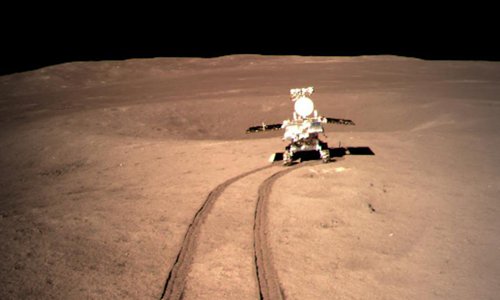HOME >> CHINA
China's lunar rover Jade Rabbit-2 breaks record of working time on Moon
Source:Xinhua Published: 2019/12/21 16:50:07

Photo provided by the China National Space Administration on Jan. 4, 2019 shows image of Yutu-2, China's lunar rover, at preset location A on the surface of the far side of the moon. Lunar rover Yutu-2 has been driving on the far side of the moon after separating from the lander and scientific devices on both the lander and rover are currently gathering data, the China National Space Administration (CNSA) said late Friday. (Xinhua)
China's Jade Rabbit-2, or Yutu-2, has become the longest-working lunar rover on the moon, as it started to work for the 13th lunar day on the far side of the moon.
Previously the record was held by Lunokhod 1, the Soviet robotic rover that became the world's first to be sent to the moon in 1970, where it worked for about 10 months.
China's Chang'e-4 probe including a lander and Jade Rabbit-2, launched on Dec. 8, 2018, made the first-ever soft landing on the Von Karman Crater in the South Pole-Aitken Basin on the far side of the moon on Jan. 3, 2019.
Both the lander and rover have resumed work for the 13th lunar day after laying dormant during the extremely cold night, according to the Lunar Exploration and Space Program Center of the China National Space Administration.
The lander woke up at 5:14 a.m. Saturday (Beijing time), and the rover awoke at 6:43 p.m. Friday. Both are in normal working order.
The rover has driven more than 345 meters on the far side of the moon to conduct a scientific exploration of the virgin territory.
A lunar day equals 14 days on Earth, a lunar night is the same length. The Chang'e-4 probe switches to dormant mode during the lunar night due to a lack of solar power.
The scientific tasks of the Chang'e-4 mission include conducting low-frequency radio astronomical observation, surveying the terrain and landforms, detecting the mineral composition and shallow lunar surface structure and measuring neutron radiation and neutral atoms.
The Chang'e-4 mission embodies China's hope to combine wisdom in space exploration with four payloads developed by the Netherlands, Germany, Sweden and Saudi Arabia.
Posted in: SOCIETY,CHINA FOCUS